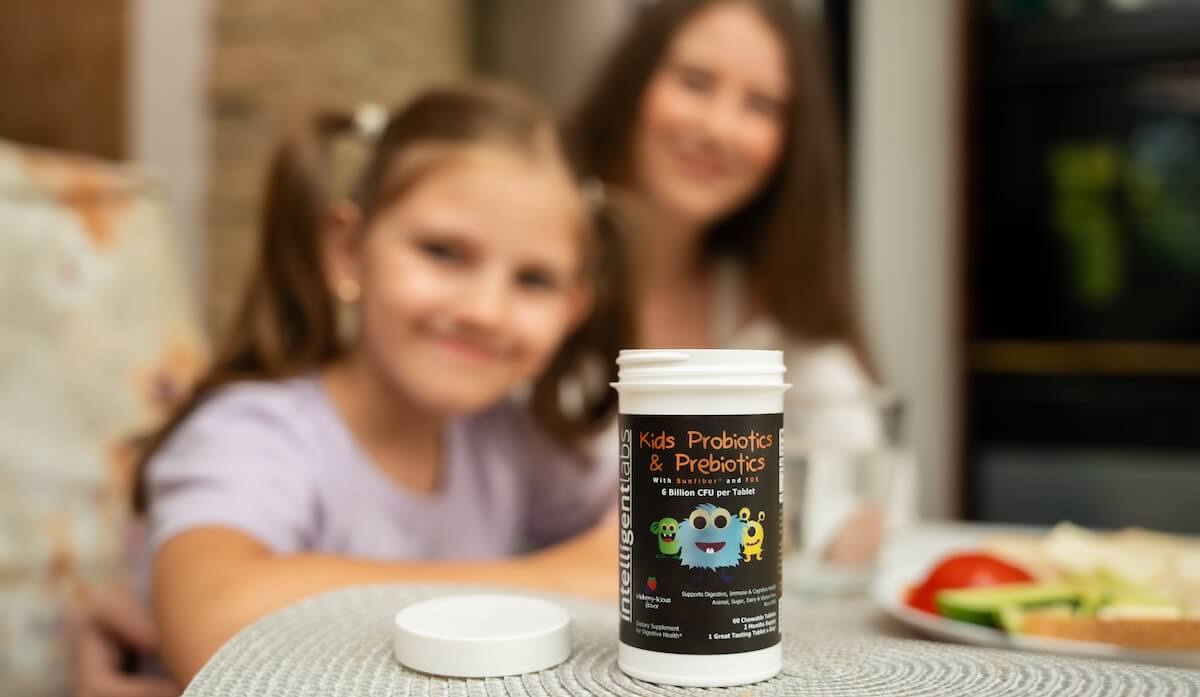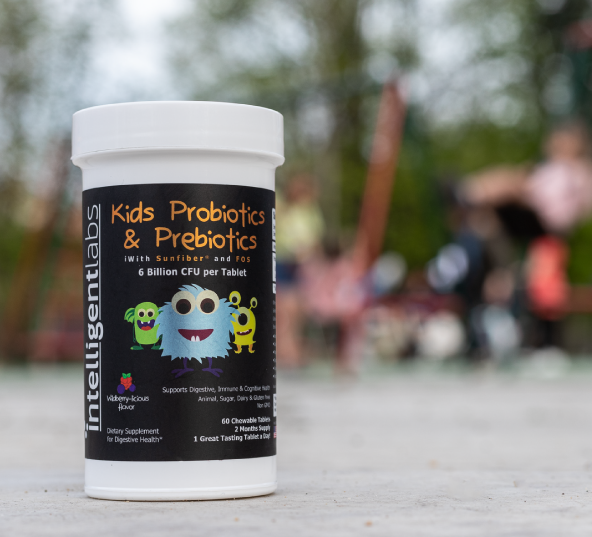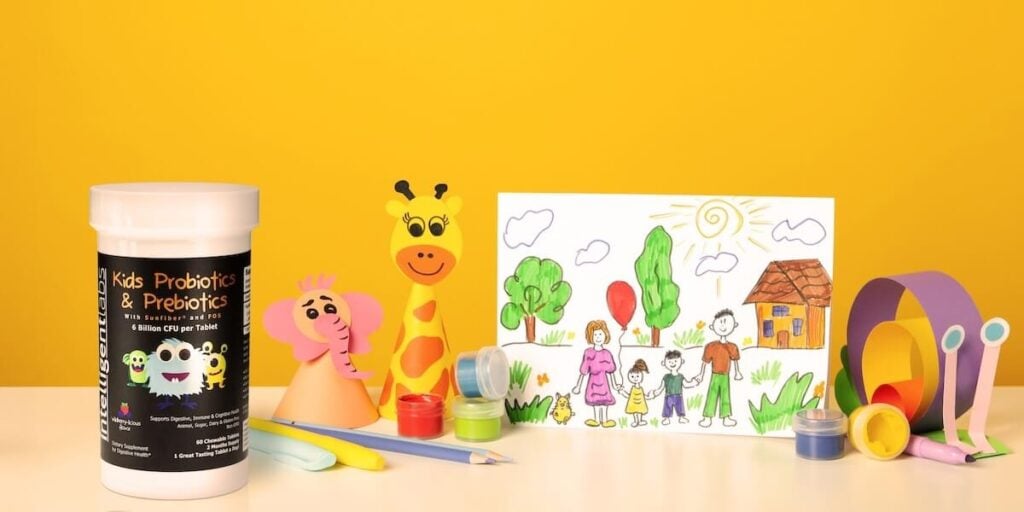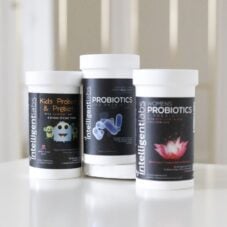Nutrition
Probiotics for Kids: A Complete Evidence-Based Guide for Parents
In this article, we are going to discuss probiotics for kids – how they work and how to choose the best probiotic sources. We’re also going to talk about your child’s immune system and digestive health. Use our article as a guide, and talk to your pediatrician before giving your kids probiotics, or any dietary supplement, for that matter.
Table of Contents
Your child’s microbiome and why it’s vital to keep it healthy
A child’s gut microbiome plays an important role in their health, starting from birth and continuing through childhood and beyond. It’s made up of bacteria and microorganisms, with about 80% of the immune system residing in the gut. Both good and bad bacteria coexist in the microbiome, but an imbalance, known as dysbiosis, can lead to health problems. 1 2
The first 1,000 days of a baby’s life are crucial for developing their immune system, as they’re exposed to new bacteria and viruses. While mothers pass on antibodies, children need to develop their own immunity. Probiotics may help by promoting gut health, supporting digestion, and boosting immunity.2
A healthy microbiome also helps with metabolism and nutrition, while an imbalance increases the risk of allergies, infections, gastrointestinal issues, and chronic conditions like IBS, IBD, obesity, and diabetes.3 4
What are factors that contribute to an unbalanced microbiome in kids?
Probiotics are literally bacteria, but the good kind. These microbes help maintain a balanced gut microbiome, however, a number of factors can disrupt this balance:
1) Cesarean delivery
Babies born vaginally receive healthy bacteria from their mother, supporting microbiome development.3 In contrast, C-section babies miss this exposure since they don’t pass through the birth canal. Thus, C-section babies are more prone to dysbiosis since they don’t have as diverse a microbiota as those delivered vaginally.5
2) Antibiotics
While effective against bacterial infections, antibiotics kill both good and bad bacteria. For young children with developing immune systems, this can increase the risk of inflammatory conditions later in life.6
3) Hygiene hypothesis
Good hygiene is important. However, over-sanitized environments limit exposure to beneficial bacteria, potentially disrupting the microbiome and affecting immune development.7

What’s the best source of probiotics for kids?
There are two easy ways to get probiotics in your child – food and supplement. While both are good sources of beneficial bacteria, there are certain advantages and disadvantages for both.
Probiotic Food
Ideally, we should be getting our nutrients from natural, unprocessed foods. In this case, the best food sources of probiotics that kids would love would be fermented foods, such as:
- cheese
- yogurt (make sure it says live and active bacteria on the label)
- kefir
- tempeh
- pickles
- homemade probiotic ketchup
Older kids may appreciate the taste of more exotic fermented foods like miso, kimchi, sauerkraut, and kombucha.
Need tasty food ideas for kids? Check out this blog post on healthy probiotic snacks for kids!

Probiotic Supplements
The reality, however, is that most kids likely wouldn’t want to eat the same fermented food every single day (may eventually lead to food intolerance), which is where probiotic supplements come in super handy. They come in all forms and sizes, but the best ones that kids are sure to love are gummy probiotics and chewable probiotics.
Probiotic supplements are very convenient to take. You can choose the strength (measured in CFU’s or colony-forming units) and there’s usually a variety of probiotic strains to choose from.
Some brands even include prebiotics or fiber, like our 6 Billion CFU Kid’s Probiotics and Prebiotics. Supplements also last way longer than any fermented probiotic food!
So, what’s the best source of probiotics for children?
Well, here’s a table summarizing the different pros and cons of these two probiotic sources:
| Probiotic Source | Pros | Cons |
| Food | * delicious! * more nutritious * more filling * with vitamins and minerals | * unknown CFU per serving * can go rancid pretty quickly * picky eaters may not like the taste |
| Supplement | * more CFU’s per capsule * more probiotic strains * added prebiotic fiber * delayed-release capsules * long shelf life * affordable * very convenient to take | * not as tasty |
That said, a mixture of food and supplement would be the best! Your child gets to eat nutritious probiotic-rich food. But on days he or she wants to eat something else, a probiotic supplement would be the next best thing.
How to choose the best kids probiotics?
Choosing the right probiotic for your child can be challenging, but these key factors will help guide your decision:
- Patented Probiotic Strains: Look for well-researched strains with proven health benefits. Generic strains may not provide the same results.
- Supplement Strength (CFU): For kids, choose a probiotic with at least 5 billion CFU to ensure sufficient bacteria to balance their gut microbiome.
- Prebiotics: Prebiotics are fibers that help probiotics thrive. A combined probiotic and prebiotic supplement ensures the bacteria’s survival.
- No Refrigeration Needed: High-quality probiotics don’t require refrigeration, ensuring they remain effective even after shipping.
- Kid-Friendly Flavor: Choose a sugar-free, natural flavor that kids will enjoy, ideally in chewable form to make it easier for younger children.
- Third-Party Lab Tested: Ensure the product is independently tested for purity and strength, ensuring the product’s claims are accurate.
Intelligent Labs Kids Probiotics meets all these criteria:
- 6 billion CFU per tablet from Lactobacillus acidophilus and Bifidobacterium lactis strains
- Includes prebiotics like Sunfiber® and FOS for synbiotic benefits
- No refrigeration needed thanks to Active Packaging Technology
- Wildberry flavor, sugar-free, chewable tablets
- Third-party lab tested for quality (check reports here)
8 health benefits of giving probiotics to your kids
Here’s what probiotic foods and supplements can do for your child:
1) Digestive health benefits
Probiotics help promote overall gastrointestinal health and function. Imbalance in the gut microbiota has been linked to various health issues, such as irritable bowel disease, irritable bowel syndrome, obesity, type 2 diabetes, and atopy.4
A clinical report published in Pediatrics shows that probiotics can help healthy children with acute viral gastroenteritis and antibiotic-associated diarrhea.8 Additionally, the strain Lactobacillus rhamnosus GG can help prevent nosocomial or hospital-acquired diarrhea.9
For constipated children, probiotics can also help increase stool frequency.10 The probiotic strain Bifidobacterium lactis (a strain present in our Kid’s Probiotics with Prebiotics supplement) was also found to have significantly reduced the frequency and duration of diarrhea, as well as the length of hospital stay.11
2) Respiratory health benefits
The health benefits of probiotics for kids go beyond their digestive system. A 2015 systematic review found that probiotics were able to reduce the number of new episodes of respiratory tract infections (RTI) in children up to 10 years old.12
Another study confirms this finding, saying that probiotics, specifically Lactobacillus, helped reduce the duration of RTI’s in children attending daycare centers.13
Moreover, probiotics were proven to be more effective than placebo at reducing the number of cold-related school absences as well as antibiotic use in children.14
3) Skin health benefits
Skin conditions such as eczema and atopic dermatitis are common in young children. A double-blind study conducted on children aged 1 to 18 years old showed that probiotics (two different Lactobacillus strains) helped improved atopic dermatitis symptoms. The positive effects continued even after they stopped taking probiotics.15
4) Fights inflammation
Many common health problems are brought about by inflammation. This includes childhood obesity, colitis, diabetes, and metabolic syndrome. A 2018 study reports that probiotics may help prevent metabolic syndrome and improve overall health.16

5) Weight management
According to research, a healthy gut microbiome may help with your child’s weight management throughout life. Probiotics may help promote weight and height gain in undernourished children.17 It’s therefore in your child’s best interest to eat as much probiotic-rich food or supplement with a high-quality probiotic for kids.
6) Supports brain development
Our gut is linked to the brain and spine via the gut-brain axis, and gut bacteria play a key role in this axis. A healthy gut microbiome is important for a healthy brain. In fact, it’s often called the “second brain.” One study showed that a multi-strain probiotic administered to healthy volunteers had an influence on brain activity, especially emotional decision-making and emotional memory.18
7) Urinary tract health
Urinary tract infections are caused by bad bacteria. Good bacteria, aka probiotics, may help support vaginal and urinary tract health in female children by keeping good bacteria populations at optimal levels.19
8) Boosts overall immunity
As mentioned earlier, our gut and our immune system are closely linked due to the fact that the majority of our immune cells reside in the gut.2 By taking probiotics, your child is getting protection from various pathogens which, in turn, helps reduce the risk of various health problems, such as digestive issues, respiratory issues, and inflammation.
There are many other health benefits associated with taking probiotics. Check out our ultimate guide to probiotic supplements here.
Who shouldn’t take probiotics?
Probiotics shouldn’t be given to infants and kids who are immunocompromised, seriously or chronically ill.4 Even with healthy individuals, always seek medical advice from a doctor before giving your kids any probiotics.
Are probiotics safe for infants?
Taking probiotics is generally considered safe for healthy infants and toddlers. It can help prevent and treat diarrhea (both antibiotic-associated and not). Likewise, these beneficial bacteria can also help prevent colic and other gastrointestinal problems in infants.20
Amongst low birth weight infants, probiotics were found to be beneficial in the prevention of severe necrotizing enterocolitis, late-onset sepsis, and even mortality!21
Babies delivered vaginally may have a more diverse microbiota courtesy of mom, but with probiotics, cesarean babies also get to enjoy a more robust immune response.22
Another study found that probiotics were able to protect infants against eczema and rhinoconjunctivitis for at least 2 more years after they stopped taking probiotics, suggesting long-term protection against allergies and skin issues.23
When is the best time to give probiotics to kids?
You can give probiotics at any time, however, we generally recommend taking them with a meal, such as breakfast. Food will lower the stomach’s acidity which is beneficial for the bacteria. Our probiotic strains are chosen for their heat, stomach acid, and bile-resistant properties, but every little bit helps.
Any side effects to watch out for?
During the first few days, expect a little gas, bloating, or even diarrhea. This is the body’s natural response to more bacteria being introduced in the gut and the microbiome is rebalancing itself. These are actually signs that the probiotics are working!
💬 Something on your mind? Share your thoughts in the comments. We love hearing from curious minds.
📩 And while you’re here, join our newsletter for more smart stuff (and secret perks)!
References:
- D’Argenio, Valeria. “The Prenatal Microbiome: A New Player for Human Health.” High-throughput vol. 7,4 38. 11 Dec. 2018, doi:10.3390/ht7040038 ↩︎
- Belkaid, Yasmine, and Timothy W Hand. “Role of the microbiota in immunity and inflammation.” Cell vol. 157,1 (2014): 121-41. doi:10.1016/j.cell.2014.03.011 ↩︎
- Arrieta, Marie-Claire et al. “The intestinal microbiome in early life: health and disease.” Frontiers in immunology vol. 5 427. 5 Sep. 2014, doi:10.3389/fimmu.2014.00427. ↩︎
- Bull, Matthew J, and Nigel T Plummer. “Part 1: The Human Gut Microbiome in Health and Disease.” Integrative medicine (Encinitas, Calif.) vol. 13,6 (2014): 17-22. ↩︎
- Decreased gut microbiota diversity, delayed Bacteroidetes colonisation and reduced Th1 responses in infants delivered by Caesarean section. Gut 2014;63:559-566. ↩︎
- Misra, Ravi S. “The Microbiome, Antibiotics, and Health of the Pediatric Population.” EC microbiology vol. 3,1 (2016): 388-390. ↩︎
- Okada, H, C Kuhn, H Feillet, and J-F Bach. “The ‘hygiene hypothesis’ for autoimmune and allergic diseases: an update.” Clin Exp Immunol 160, no. 1 (2010): 1–9. doi: 10.1111/j.1365-2249.2010.04139.x. ↩︎
- Thomas, D. W., and F. R. Greer. “Probiotics and Prebiotics in Pediatrics.” PEDIATRICS, vol. 126, no. 6, 2010, pp. 1217–31. Crossref, doi:10.1542/peds.2010-2548. ↩︎
- Hojsak, Iva et al. “Probiotics for the Prevention of Nosocomial Diarrhea in Children.” Journal of pediatric gastroenterology and nutrition vol. 66,1 (2018): 3-9. doi:10.1097/MPG.0000000000001637 ↩︎
- Huang, Ruixue, and Jianan Hu. “Positive Effect of Probiotics on Constipation in Children: A Systematic Review and Meta-Analysis of Six Randomized Controlled Trials.” Frontiers in cellular and infection microbiology vol. 7 153. 28 Apr. 2017, doi:10.3389/fcimb.2017.00153 ↩︎
- Abou El-Soud, Neveen Helmy, et al. “Bifidobacterium Lactis in Treatment of Children with Acute Diarrhea. A Randomized Double Blind Controlled Trial.” Open Access Macedonian Journal of Medical Sciences, vol. 3, no. 3, 2015, pp. 403–07. Crossref, doi:10.3889/oamjms.2015.088. ↩︎
- Araujo, Georgia Véras de et al. “Probiotics for the treatment of upper and lower respiratory-tract infections in children: systematic review based on randomized clinical trials.” Jornal de pediatria vol. 91,5 (2015): 413-27. doi:10.1016/j.jped.2015.03.002 ↩︎
- Laursen, Rikke Pilmann, and Iva Hojsak. “Probiotics for respiratory tract infections in children attending day care centers-a systematic review.” European journal of pediatrics vol. 177,7 (2018): 979-994. doi:10.1007/s00431-018-3167-1 ↩︎
- Hao, Qiukui et al. “Probiotics for preventing acute upper respiratory tract infections.” The Cochrane database of systematic reviews ,2 CD006895. 3 Feb. 2015, doi:10.1002/14651858.CD006895.pub3 ↩︎
- Wang, I-J, and J-Y Wang. “Children with atopic dermatitis show clinical improvement after Lactobacillus exposure.” Clinical and experimental allergy : journal of the British Society for Allergy and Clinical Immunology vol. 45,4 (2015): 779-87. doi:10.1111/cea.12489 ↩︎
- Torres, Sebastian et al. “Adipose tissue inflammation and metabolic syndrome. The proactive role of probiotics.” European journal of nutrition vol. 58,1 (2019): 27-43. doi:10.1007/s00394-018-1790-2 ↩︎
- Onubi, Ojochenemi J., et al. “Effects of Probiotics on Child Growth: A Systematic Review.” Journal of Health, Population and Nutrition, vol. 34, no. 1, 2015. Crossref, doi:10.1186/s41043-015-0010-4. ↩︎
- Bagga, Deepika et al. “Probiotics drive gut microbiome triggering emotional brain signatures.” Gut microbes vol. 9,6 (2018): 486-496. doi:10.1080/19490976.2018.1460015 ↩︎
- Schwenger, Erin M et al. “Probiotics for preventing urinary tract infections in adults and children.” The Cochrane database of systematic reviews ,12 CD008772. 23 Dec. 2015, doi:10.1002/14651858.CD008772.pub2 ↩︎
- Barnes, Danielle, and Ann Ming Yeh. “Bugs and Guts: Practical Applications of Probiotics for Gastrointestinal Disorders in Children.” Nutrition in clinical practice : official publication of the American Society for Parenteral and Enteral Nutrition vol. 30,6 (2015): 747-59. doi:10.1177/0884533615610081 ↩︎
- Dermyshi, Elda et al. “The “Golden Age” of Probiotics: A Systematic Review and Meta-Analysis of Randomized and Observational Studies in Preterm Infants.” Neonatology vol. 112,1 (2017): 9-23. doi:10.1159/000454668 ↩︎
- Holscher, Hannah D et al. “Bifidobacterium lactis Bb12 enhances intestinal antibody response in formula-fed infants: a randomized, double-blind, controlled trial.” JPEN. Journal of parenteral and enteral nutrition vol. 36,1 Suppl (2012): 106S-17S. doi:10.1177/0148607111430817 ↩︎
- Wickens, K et al. “A protective effect of Lactobacillus rhamnosus HN001 against eczema in the first 2 years of life persists to age 4 years.” Clinical and experimental allergy : journal of the British Society for Allergy and Clinical Immunology vol. 42,7 (2012): 1071-9. doi:10.1111/j.1365-2222.2012.03975.x ↩︎





